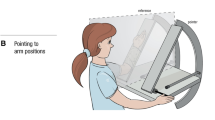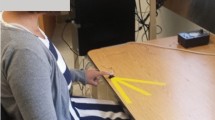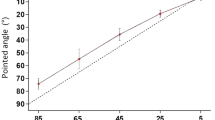Summary
Proprioception in the neck was investigated in normal human subjects. Three experiments studied rotation of the head about a vertical axis on the body. Accuracy of pointing, thresholds for detection of passive movement, and control of fine movement were tested. Comparison of the accuracy of pointing at the big toe with the nose and with the arm, showed a smaller scatter of angular misalignments when pointing with the arm. However, the arm pointed systematically off target. Pointing at the target toe by turning the head was not significantly more accurate than aligning the nose and toe by turning the chair and body with the head fixed. The highest threshold found for the detection of the direction of passive movement of the head relative to the body was 1.4° angular displacement. Thresholds were highest at the slowest angular velocity and dropped as angular velocity increased. When the head was turned on the body thresholds were lower than when the body was turned and the head held still. Control of fine angular movements of the head and of the distal phalanx of the right thumb were compared by measuring subjects' accuracy in guiding a cursor through a path on a computer screen by turning the head or moving the thumb. The thumb was found to be better controlled than the head.
Similar content being viewed by others
References
Abrahams VC, Falchetto S (1969) Hind leg ataxia of cervical origin and cervico-lumbar interactions with a supratentorial pathway. J Physiol 203: 435–447
Abrahams VC (1982) Neck muscle proprioception and motor control. In: Garlick D (ed) Proprioception, posture and emotion. University of New South Wales Committee in Postgraduate Medical Education, Sydney, pp 103–120
Bakker DA, Richmond FJR (1982) Muscle spindle complexes in muscles around upper cervical vertebrae in the cat. J Neurophysiol 48: 62–74
Becker W, Deecke L, Mergner T (1979) Neuronal responses to natural vestibular and neck stimulation in the anterior suprasylvian gyrus of the cat. Brain Res 165: 139–143
Clark FJ, Burgess RC, Chapin JW, Lipscomb WT (1985) Role of intramuscular receptors in the awareness of limb position. J Neurophysiol 54: 1529–1540
Cohen LA (1958) Analysis of position sense in human shoulder. J Neurophysiol 21: 550–562
Cohen LA (1961) Role of eye and neck proprioceptive mechanisms in body orientation and motor coordination. J Neurophysiol 24: 1–11
Colebatch JG, McCloskey DI (1987) Maintenance of constant arm position or force: reflex and volitional components. J Physiol 386: 247–261
De Domenico G, McCloskey DI (1987) Accuracy of voluntary movements at the thumb and elbow joints. Exp Brain Res 65: 471–478
Goldscheider A (1889) Untersuchungen über den Muskelsinn. Arch Anat Physiol 3: 369–502
Gray H (1980) Gray's anatomy, 36th edition. Williams PL, Warwick R (ed) Churchill Livingstone, Edinburgh, pp 446–448
Guedry FE (1974) Psychophysics of vestibular sensation. In: Kornhuber HH (ed) Handbook of sensory physiology, Vol VI/2. Vestibular system. Springer, Berlin Heidelberg NewYork, pp 1–154
Hall LA, McCloskey DI (1983) Detection of movements imposed on finger, elbow and shoulder joints. J Physiol 335: 519–533
Jakobs T, Miller JAA, Schultz AB (1985) Trunk position sense in the frontal plane. Exp Neurol 90: 129–138
Jong JM de, Bles W, Bovenkerk G (1981) Nystagmus, gaze shift and self-motion perception during sinusoidal head and neck rotation. Ann NY Acad Sci 374: 590–599
Lund S (1980) Postural effects of neck muscle vibration in man. Experientia 36: 1398
McCloskey DI (1973) Differences between the senses of movement and position shown by the effects of loading and vibration of muscles in man. Brain Res 61: 119–131
Manzoni D, Pompeiano O, Stampacchia G (1979) Cervical control of posture. Brain Res 169: 615–619
Mergner T, Deecke L, Becker W (1981) Patterns of vestibular and neck responses and their interaction: a comparison between cat cortical neurons and human psychophysics. Ann NY Acad Sci 374: 361–372
Mergner T, Nardi GL, Becker W, Deecke L (1983) The role of canal-neck interaction for the perception of horizontal trunk and head rotation. Exp Brain Res 49: 198–208
Paillard J, Brouchon M (1968) Active and passive movements in the calibration of position sense. In: Freedman SJ (ed) The neuropsychology of spatially oriented behaviour. Dorsey Press, Illinois, pp 37–55
Richmond FJR, Abrahams VC (1975) Morphology and distribution of muscle spindles in dorsal muscles of the cat neck. J Neurophysiol 38: 1322–1339
Richmond FJR, Bakker DA (1982) Anatomical organisation and sensory receptor content of soft tissues surrounding upper cervical vertebrae in the cat. J Neurophysiol 48: 49–61
Taylor JL, McCloskey DI (1987a) Proprioception in the neck. Neurosci Lett 27: S130
Taylor JL, McCloskey DI (1987b) Pointing. Neurosci Lett 27: S131
Author information
Authors and Affiliations
Rights and permissions
About this article
Cite this article
Taylor, J.L., McCloskey, D.I. Proprioception in the neck. Exp Brain Res 70, 351–360 (1988). https://doi.org/10.1007/BF00248360
Received:
Accepted:
Issue Date:
DOI: https://doi.org/10.1007/BF00248360




